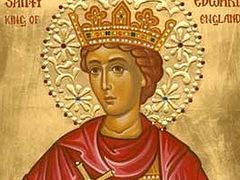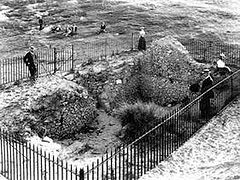Bath, England, January 30, 2020
 Coronation of St. Edgar. Photo: ancient-origins.net
Coronation of St. Edgar. Photo: ancient-origins.net
The oldest Anglo-Saxon structure in Bath, England was uncovered recently during renovations at the famous Bath Abbey.
It’s long been known that a monastery once stood on the site, experts from Wessex Archaeology, an archaeological company and charity in England, note, and it’s believed that the two recently-uncovered stone buildings belong to the ensemble of the ancient monastery, the site where St. Edgar the Peaceful was crowned as the first King of England in 973, reports Bath Echo.
 Bath Abbey. Photo: Ian Woolcock /Adobe Stock
Bath Abbey. Photo: Ian Woolcock /Adobe Stock
The two structures were discovered during excavations south of the current Abbey church. Fragments of charcoal from an internal plaster render on the semi-circular structures were sent for radiocarbon dating at Queen’s University in Belfast, which determined the buildings date to 780-910 and 670-770, to a time when the English Church was firmly Orthodox.
“In a post-Roman context, the most likely place to find this type of structure is at the east end of an ecclesiastical building, such as a church or chapel, and given the fact that the excavated structures are surrounded by late Saxon burials, this is the most likely explanation for their use. This, together with the late Saxon stonework and burials found at the Abbey, provides increasingly strong evidence that we have indeed found part of Bath’s lost Anglo-Saxon monastery,” explained Wessex Archaeology Senior Project Officer Cai Mason.
Live Science explains the connection between Bath and King St. Edgar:
Edgar, who was already crowned king of Mercia (an Anglo-Saxon kingdom in England) and Northumbria, became king of Wessex and the de facto king of all England when his brother Eadwig died in 959. He chose Bath, as it had a famous church and connections to both Wessex and Mercia, for the holy site where he would be coronated, according to Wessex Archaeology. Granted, Edgar's father and grandfather had also been recognized as kings of England, but Edgar was the first to be crowned in a ceremony that the church said was the will of God.
The Reverend Canon Guy Bridgewater at Bath Abbey, said: “This is a really exciting find. While we’ve always known there once was an Anglo-Saxon monastery on this site, no trace of the building remains above ground today, so it’s amazing that we now have an actual record of it and can get a real sense of it as it was.”
 Excavations of the possible Anglo-Saxon monastery at Bath Abbey. Photo: Wessex Archaeology
Excavations of the possible Anglo-Saxon monastery at Bath Abbey. Photo: Wessex Archaeology
However, given that the potential dates of these structures span 200 years, there are other possible identifications of the buildings.




